Hanami uses ROM-RB to implement the persistence layer, and if it comes to SQL databases, ROM uses Sequel to manage SQL connections.
But WHY? Why not ActiveRecord?
I wondered about the reasons behind that. I knew there are issues with ActiveRecord and I did face some of them in my career, but I wanted to know the exact pain points and why Sequel is better than ActiveRecord in enough different areas to be chosen by the Hanami team.
Recently I've seen this great Youtube V1ideo summary, comparing ActiveRecord With Sequel by Janko Marohnić. I've been amazed and immediately took a lot of notes.
Big Kudos to Janko for his work! My article is mostly the summary of his presentation, his articles, and collected findings from my own experience and other resources related to this topic.
This article is a result of what I got from this video and further exploring of the topic. Because Hanami uses Sequel under the hood, I've found it interesting to compose this short article from the findings.
Hope you'll find it useful too!
You can check out the video here!
important
It's important to mention that Sequel is an implementation detail in rom-sql and eventually Sequel will be replaced in ROM with a custom SQL builder (see https://github.com/sql-rb/sql-composer).
What is Sequel?
For those who don't know, Sequel is a ruby ORM, an ActiveRecord's alternative, developed to communicate with databases easily. It can be used in any ruby application and indirectly (through ROM dependency) is an ORM of choice for Hanami framework.
There are already a lot of comparisons out there, and I'll link to those in the resources of this article, but I could not hesitate to write my own, focusing on Hanami usage.
Here are the main points that Janko covered, which actually make Sequel better choice than ActiveRecord for any sql-based ruby application.
- Confident Design
- Explicitness
- No global State
- Complexity management
- Performance
- Features
Below I will describe some of them, adding my own, in a more detailed manner but first, for people who don't like reading, is my summary.
Why Hanami uses ROM (and Sequel) over ActiveRecord?
When you will go through the video above or the details below, the answer should become obvious.
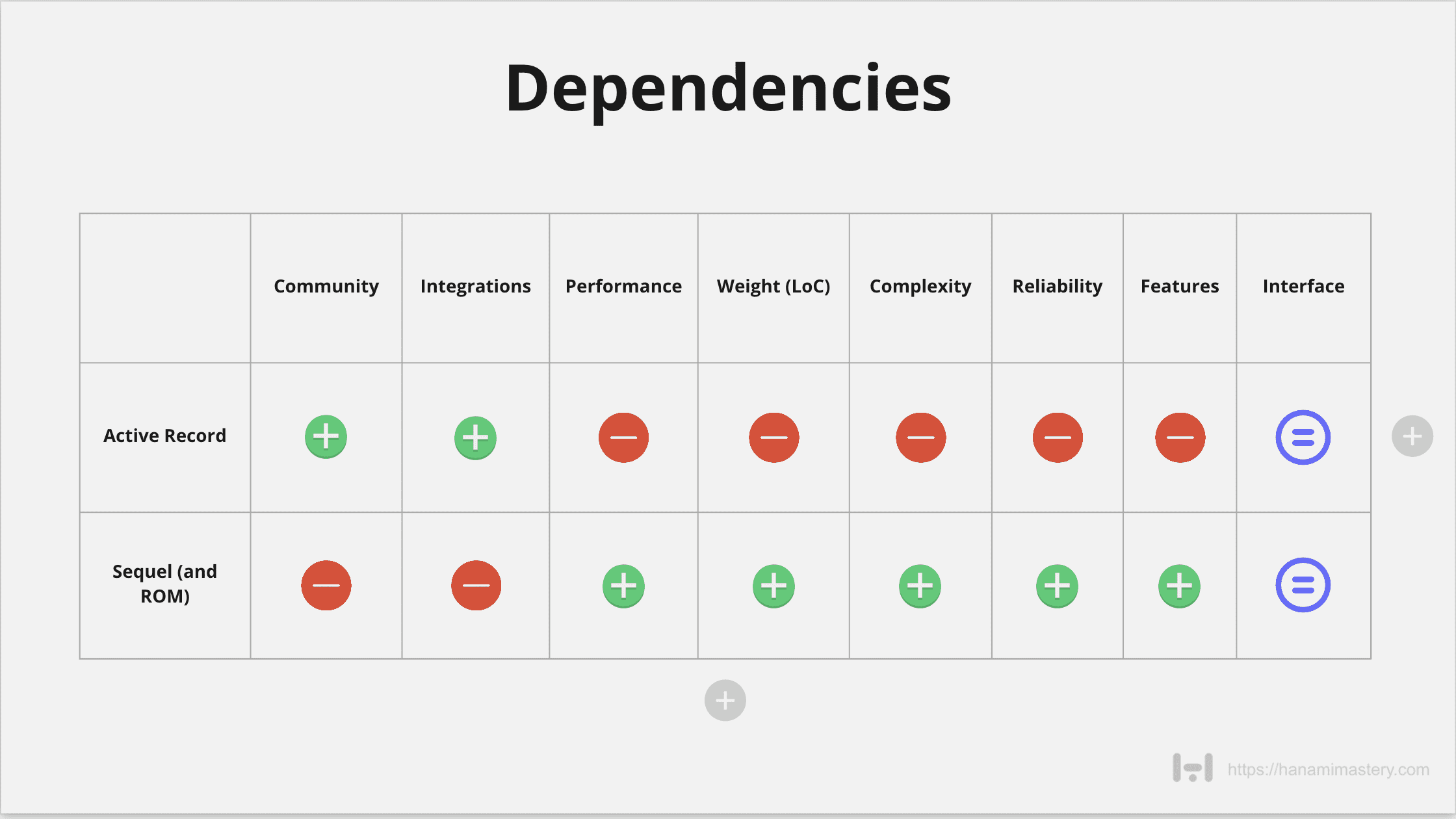 Sequel vs Active Record
Sequel vs Active Record
Disclaimer: Plus means advantage over the other option.
Sequel wins in almost all meaningful categories, and the only thing that speaks for ActiveRecord seems to be the fact that there is a greater community around it so it's richer in terms of available learning resources or compatible gems built by developers all around the world.
I do understand the reasons behind choosing Sequel and ROM as a default ORM for the Hanami application framework.
The core Hanami team just chooses the best available tool for the job, not the most popular one.
And I think it's great!
With this, if we could improve the community around ROM and Sequel, we would improve on available resources and integrations! I totally support this philosophy, as this is why I started Hanami Mastery in the first place.
Now let's talk about the main points above in depth.
Confident design
Confident design in programming means basically that your program behaves as it's expected to.
Confident desing touches different levels of creating applications, from designing website UI, to designing libraries, classes, or single functions.
Obviously on different levels, it'll matter for different users. Let's start from something obvious.
Confident design in web UI design
In UI, confident design is all about components that people can use confidentially, knowing what the app will do before they do the interaction. A very simple example of that is my Hamburger menu on HanamiMastery mobile view.
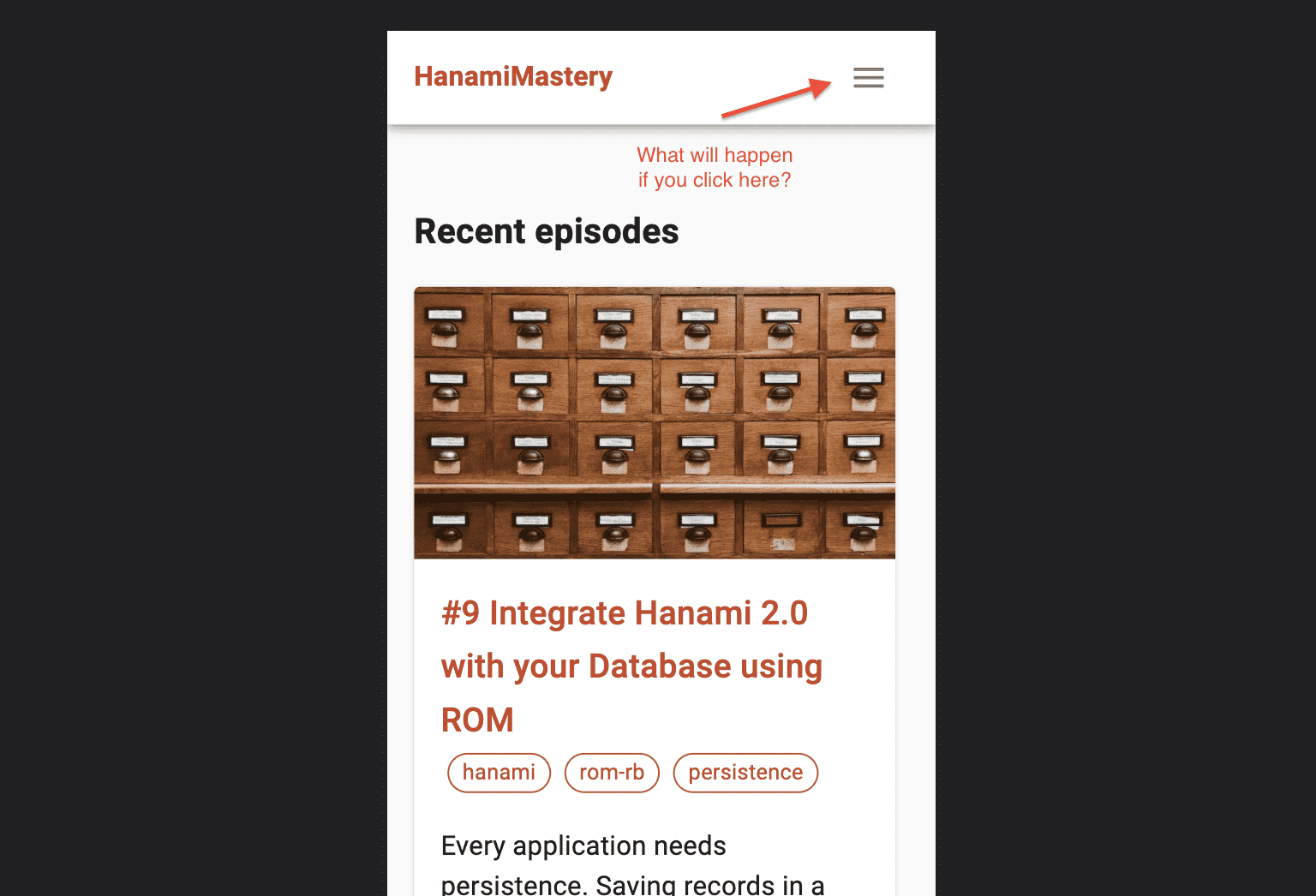 Confident design in UI
Confident design in UI
You can guess what will happen if you'll click it, no?
Confident design covers all kinds of components behavior, looks, etc. When a user sees something and can use it without thinking, it's a good confident design.
Confident design in programming
However, it comes down to the lower levels too. For programming libraries, developers are users.
If I design a library that can be used by developers confidentially, it's a sign of a well-designed library. You can apply this thought to classes and methods too, or even the API endpoints!
So how does this all apply to activerecord and sequel?
Active Record WAT's
1. Gem's name
Ruby's convention method for naming gems comes down to this.
- "MyGem" => "my_gem"
- "My::Gem" => "my-gem"
Therefore, If I know the ActiveRecord class name, I'd expect the gem to be named: active_record.
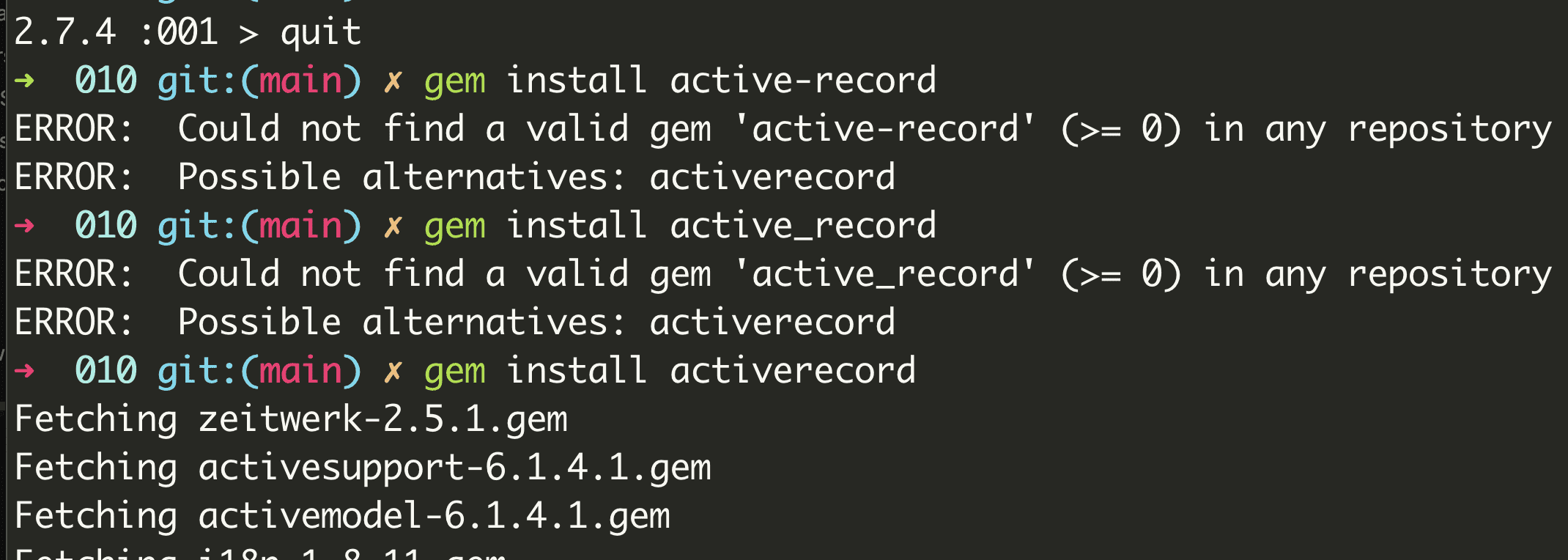 ActiveRecord naming issue
ActiveRecord naming issue
But it's not as I would expect.
Fortunately, when it comes to require, the name follows the convention.
require 'active_record'
This one is not a big deal, especially as most people using ActiveRecord do it because of Rails, and Rails has it listed as a dependency. No need to be strict about dependencies names I guess.
It annoyed me personally several times though, as I am a person who plays around with gems in a raw ruby environment to contribute, benchmark, and build non-standard solutions.
2. Establish Connection
The first real example of NOT confident design though is when we use establish_connection method.
When you'll establish_connection, to set up the connection with the database, then, in the console, calling an Article class, ruby will ask you to establish a connection again.
 Reaction on connection not established after calling establish_connection in ActiveRecord
Reaction on connection not established after calling establish_connection in ActiveRecord
It appears that Rails calls this establish_connection on the Article object under the hood, so we don't need to, but the funny thing is that calling establish_connection on ActiveRecord::Base does not establish anything.
Establishing connection - ActiveRecord example
Here is a simple example to showcase this behavior.
require 'irb'
require 'pg'
require 'active_record'
ActiveRecord::Base.establish_connection(
adapter: 'postgresql',
database: 'mydb'
)
class Article < ActiveRecord::Base
end
IRB.start
The code above will be executed without returning any issues, even though my Postgres server is not even running!
 Establish Connection issue
Establish Connection issue
This is certainly not something I would expect.
Establishing connection - Sequel example
Sequel does not have such an issue. When I call the connect method, it actually tries to establish a db connection, and the analogous code in case of sequel will fail immediately.
require 'irb'
require 'pg'
require 'sequel'
DB = Sequel.connect(
adapter: 'postgresql',
database: 'mydb'
)
class Article < Sequel::Model
end
IRB.start
 Expected connection establishing error
Expected connection establishing error
This is what I call confident design for libraries.
If the library behaves as we would expect to, it's less likely we'll encounter random bugs due to the inappropriate usage of the library, especially if we're creating complicated, advanced systems, like the Hanami framework.
But Wait, There is More!
3. Defining methods on Runtime.
We all know that ActiveRecord does define model methods based on table schema definition. It's super convenient and speeds up the development in the early days of the application like crazy.
I love this feature, but it's a bit less known, that ActiveRecord actually defines those methods dynamically in runtime.
So, until the first instance of my model is created, the method on the class is not defined...
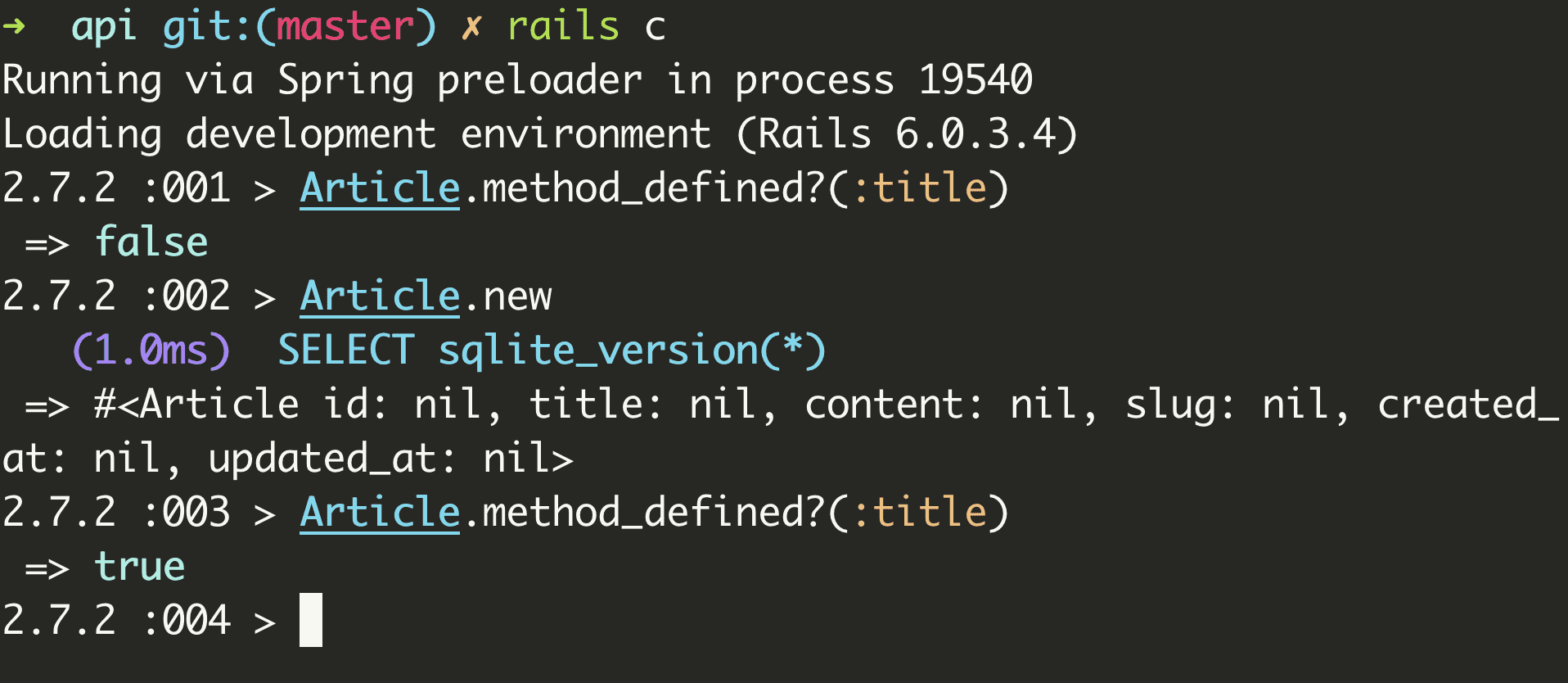 Methods defined on runtime
Methods defined on runtime
Sequel Parses the schema immediately, so you'll know immediately that the article has the title method defined, as you probably expected.
 Methods defined on build time
Methods defined on build time
Complexity
I am often annoyed by the fact the type method in Rails is reserved for STI, even though STI is something I rarely use.
After watching Janko's video, I know I'm not the only one.
Unfortunately, one of the biggest issues with activerecord is its size. Active Record is a monster, rich in features, most of which you'll probably not use, especially if you only want to develop a simple, task-focused library.
It's fine, that activerecord is rich in features, however not being able to disable them is in my opinion a very bad thing.
The Sequel, in contrast, loads by default only an essential feature set, allowing a user to have control over what should be included. All non-standard features are loadable by the plugin system, which makes Sequel more lightweight, faster, and easier to work with.
ActiveRecord::Base.ancestors # loads all the features
Sequel::Model.ancestors # loads only essentials - everything accessible by plugins.
This Really speeds up the app, improves memory management, and so on.
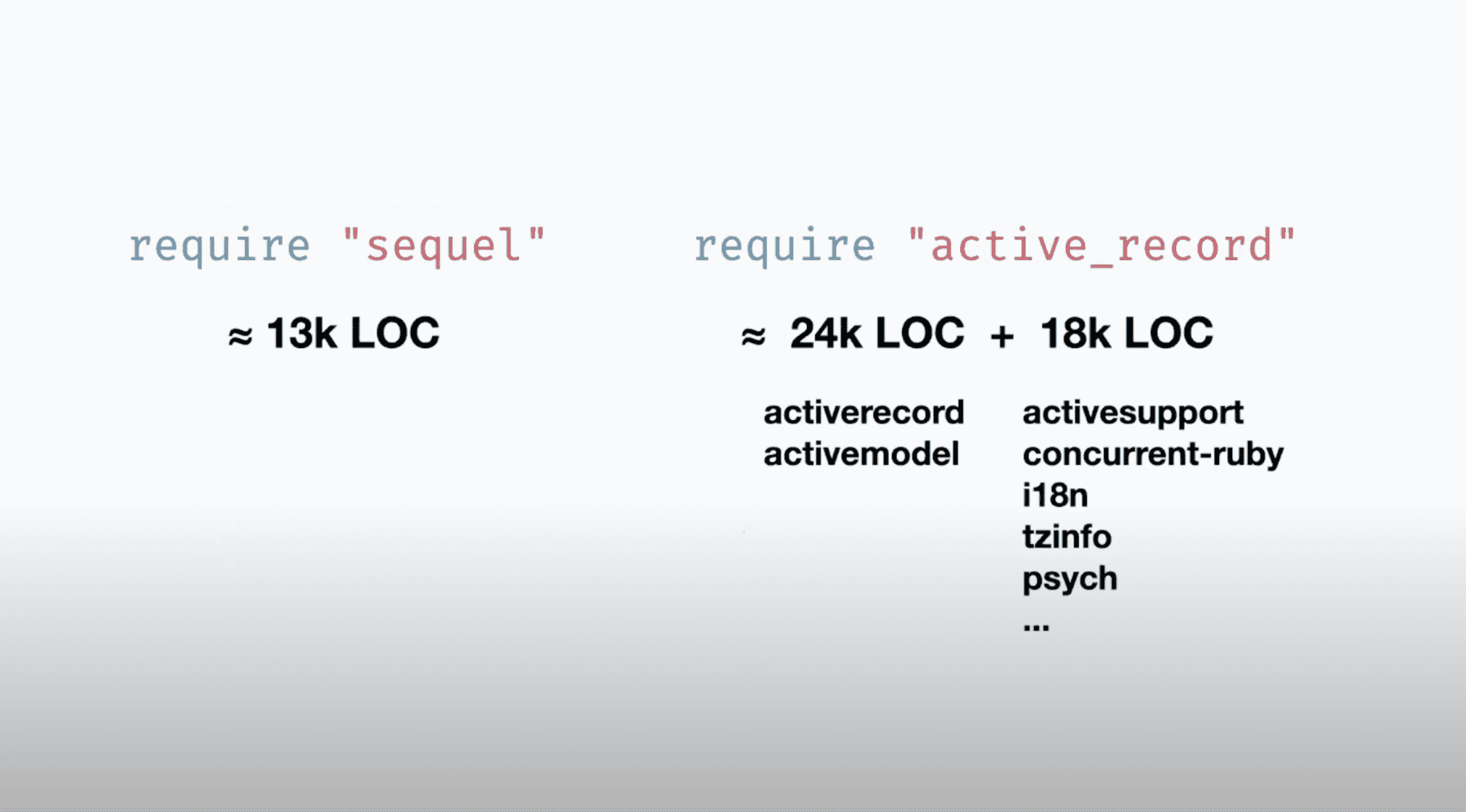 ActiveRecord and Sequel weight comparison (SRC: https://youtu.be/ftJrBpiYQXM)
ActiveRecord and Sequel weight comparison (SRC: https://youtu.be/ftJrBpiYQXM)
Summary
Sequel is really a much better library than ActiveRecord objectively. I strongly believe ActiveRecord is popular because of Rails.
Now, when I work more with Hanami, I really enjoy being exposed on Sequel too!
Keep in mind, that this article covers only a fraction of the differences. I'll extend it but in the meantime, I strongly encourage you to watch the video and read the resources linked below!
Consider support!
I hope you've enjoyed this article, and if you want to see more content in this fashion,** Subscribe to this YT channel**, Newsletter, and follow me on Twitter! As always, all links you can find the description of the video or in the https://hanamimastery.com.
References
- Sequel CheatSheet
- Ode to sequel by Janko Marohnić
- https://mrbrdo.wordpress.com/2013/10/15/why-you-should-stop-using-activerecord-and-start-using-sequel/
Thanks!
- Jon Tyson - For a great cover photo
- Janko Marohnić - for the astonishing groundwork to make this article possible.
Add your suggestion to our discussion panel!
I'll gladly cover them in the future episodes! Thank you!

